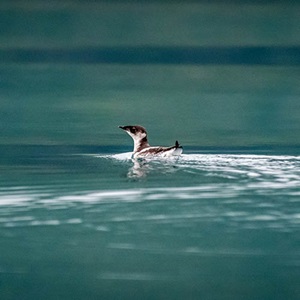Exploring the use of LED lights on gillnets and delays to the fishing season to reduce seabird bycatch in gillnets.
- Deploying LED lights on gillnets throughout the lumpfish fishing season
- Studying the overlap between seabird migration and lumpfish spawning
- Recording data on seabirds caught to improve understanding of the fishery’s impact on populations
Start date: April 2023
€46,935
(£41,465) awarded
Awardee
Dr Søren Post, Greenland Institute of Natural Resources
Fishery
Greenland lumpfish fishery
Effective bycatch mitigation methods needed
Bycatch is a common problem in gillnet fisheries worldwide, with diving seabirds particularly at risk. In Greenland alone, up to 20,000 common eider ducks become fatally entangled every year.
In recent years, research has been carried out to identify ways to reduce seabird bycatch in the MSC certified Greenland lumpfish fishery, including the addition of mesh panels to gill nets. However, further research is needed to develop effective bycatch methods that do not impact the commercial viability of the fishery.
Deterring seabirds with LED lights
The study will investigate whether gillnets modified with LED lights can effectively reduce seabird bycatch without reducing the amount of lumpfish caught. Previous studies in Peruvian gillnet fisheries found LEDs to be an effective seabird deterrent.
The researchers from the Greenland Institute of Natural Resources will specifically look at the impact of the LEDs on common eider, long-tailed duck and Atlantic halibut bycatch.
The study will investigate whether gillnets modified with LED lights can effectively reduce seabird bycatch without reducing the amount of lumpfish caught. Previous studies in Peruvian gillnet fisheries found LEDs to be an effective seabird deterrent.
Overlapping migration and spawning seasons
Previous studies have suggested that bycatch could be reduced by delaying the start of the lumpfish fishing season. This would allow the common eider to migrate away from the fishery to their summer grounds.
This study will further investigate the feasibility of this approach. While delaying fishing until the seabirds have left the region would reduce the number caught, it may also prevent fishers from targeting lumpfish during the spawning season.
“[Our research] represents a crucial step towards reducing the negative impact of bycatch… We have the potential to reduce unnecessary bycatch and ensure the sustainability of the fishery for years to come.”
Greenland Institute of Natural Resources



.tmb-thumb300.jpg?Status=Master&Culture=en&sfvrsn=11269524_1)